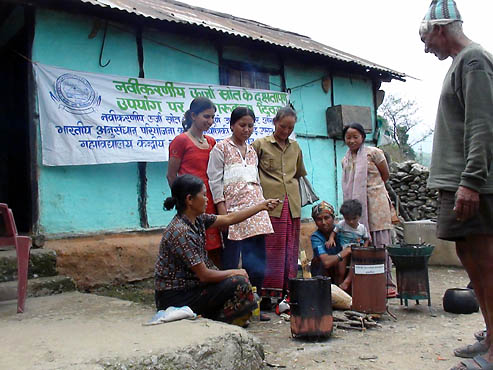GANGTOK, 24 May: The College of Agricultural Engineering and Post Harvest Technology (CAEPHT) of the Central Agricultural University (CAU) Centre of the Renewable Energy Sources (RES) conducted a one day awareness programme covering demonstration and maintenance of Biogas plants at Samlik village here in East Sikkim. The session was held at Roop Narayan Bhattarai’s house at Samlik on 04 May, informs a press communiqué received from Professor SK Rautaray, Head, FPM CAEPHT, Ranipool.
Research Engineer Dr. AK Mishra explained the generation of biogas from cow-dung and the operational parameters responsible for effective gas generation under low temperature conditions of Sikkim.
For effective biogas generation proper mixing of cow dung with water, heat treatment with hot water, regular stirring of plant slurry and regular checking of leakage from plant with soap water are important practices involved for high yield of biogas, the release adds. The climate here comes under “psychrophilic zone” (below20 0C) and mesophilic zone (24-45 0C).
The six-member family of Rinzing Bhutia of Samlik uses the biogas plant regularly for cooking, it is learnt. He informed the meeting that that he saved 2 LPG cylinders within 3 to 4 months using biogas. He was trained on maintenance of Biogas plant.
The awareness programme also introduced the gathered farmers to even more renewable energy gadgets for daily use and a live demonstration was held on different types of fuel-saving chullahs, stoves, gasifiers and sigri.
A multipurpose Sigri designed and developed at CAEPHT for roasting of fresh maize cobs was demonstrated on the day and the roasted cobs tasted and endorsed by women and children.
The Inverted Downdraft Biomass Gasifier Type Cook Stove using 1-3 kg wood or briquettes per filling is suitable for domestic use, offering the advantage of cooking/ heating with gas while using a variety of biomass fuel. In the Inverted Downdraft Gasifier the air passes upward through the biomass fuel. Due to natural convection it meets the flaming pyrolysis zone where the reaction generates charcoal and fuel gas that gives smokeless environment inside the kitchen.
The average briquett consumption of the cook stove is about 1 kg/hour, adequate for making a simple meal for a family of 4 to 5 persons.
The villagers were impressed with the performance of this stove which boiled 3-4 litres of water in 10 minutes.
The ladies appreciated the working of the gadgets and showed keen interest to adopt these for their kitchens, the release informs. At present, the farmers use higher amount of fuel-wood in the traditional chulha. It was observed that 100-150 kg wood per month is used for a 3 to 4 member family. The improved stoves using wood charcoal, briquettes and small wood chips require smaller storage space and deliver better performance. The rice husk fired Sigri was also liked by the farmers.
The neighbouring families have shown willingness to opt for the inverted downdraft gasifier and improved smokeless chulha in their kitchens due to better fuel efficiency and smokeless environment.
Interested farmers can visit CAEPHT (CAU), Ranipool to learn more about the renewable energy technologies especially the improved stoves, smokeless chulhas and improved sigris.


No comments:
Post a Comment
Readers are invited to comment on, criticise, run down, even appreciate if they like something in this blog. Comments carrying abusive/ indecorous language and personal attacks, except when against the people working on this blog, will be deleted. It will be exciting for all to enjoy some earnest debates on this blog...